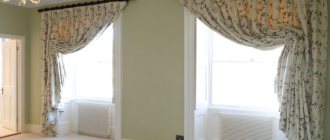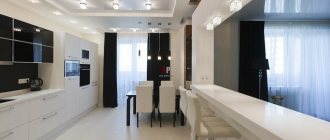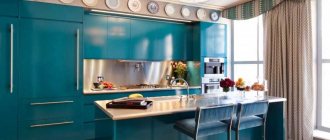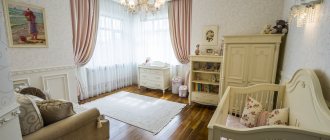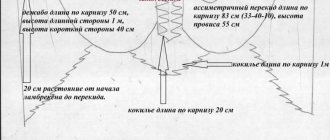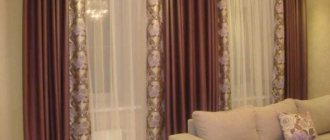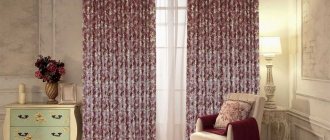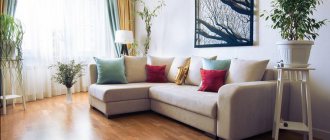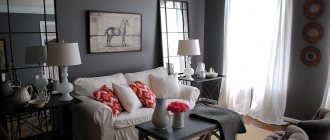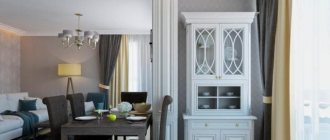The interior decoration of the living room is the character of the room in which we create a comfortable atmosphere. Living room windows are one of the most important components of an elegant interior. The stylish decoration of the windows in the hall is the central link; it will support the entire interior. One of the best window decorations for this room is a lambrequin. So, lambrequins for the hall with photos.
What is a lambrequin
According to the Wikipedia definition, it is “a horizontal decorative drapery located at the top of a curtain composition, window or door opening in the form of a short decorative element across the entire width of the cornice.”
Lambrequins, despite their historical roots (France, 15th – 18th centuries), successfully correspond to modern interior styles and fit organically into modern, high-tech, and country styles. They have many different forms, but are more typical of classics and baroque.
Lambrequins for various rooms
Curtains with lambrequins are suitable for any room. Design, fabric, colors depend on the purpose of the room, window size, and interior.
Curtains with lambrequins in the living room
When choosing a lambrequin for the living room, you should focus on the style of the room. The hard version will give the room solidity, the soft one will create a romantic atmosphere, the combined one will emphasize sophistication and at the same time remove stiffness. The fashionable openwork lambrequin is of the rigid type.
Article on the topic: Wardrobe for a children's room - which one to choose? 100 photos of beautiful models in the interior of a nursery.
Curtains with a lambrequin for the living room, made in the classical, baroque, empire style, are usually sewn luxuriously and are a complete decoration of the room. Decorations made from swags, de jabots, chill molds, and lush draperies, the sound of which is muffled by switchbacks, would be appropriate here. Curly, symmetrical, straight, asymmetrical shapes are used equally. When combining swags and flips, the latter are made from transparent fabrics.
Living room model
If curtains with a lambrequin are selected for a hall in the Art Nouveau style, then preference is given to multi-layer structures made of transparent and translucent fabrics. It would be appropriate to use floral prints, pastel colors, soft lines and outlines. Country, hi-tech and techno presuppose the presence of simple forms.
In the bedroom
To create the right ambience in the bedroom, draped decorations made of translucent fabrics are usually used. In a small room, the curtain and lambrequin have a small number of folds. The window decor is done in pastel colors without sharp contrasts.
Using a rigid structure in the bedroom is acceptable, but it makes the interior heavier and makes the ceiling visually lower.
Curtains with lambrequins for the kitchen
In a small-sized kitchen, it is better to do without the decorative design of the top of the curtains or use it separately. Air crossover or swag with de jabot goes well with roller or horizontal blinds. If you really want to hang a curtain with a lambrequin, its color should match the curtains and not be contrasting.
In a large kitchen, where the dining area is separate from the working area, the use of any decor is acceptable. Usually a combination with the dining room setting is chosen.
Basic requirements for lambrequins
If you are planning to hang beautiful curtains in a room with a lambrequin or beautiful lambrequins without curtains, then you need to know the main guidelines in order to make the right choice of options. Decorating window openings should create a mood and complement the design of the room, turning the living room into a cozy, elegant space.
Despite the variety of modifications of this decorative element, designers have identified several basic requirements that must be followed in the manufacture and placement of products:
- The lambrequin is placed only at the top of the curtain composition.
- Decorative drapery should be in harmony in fabric and color scheme with the main curtain ensemble (to match the main fabric or its shades, colors of a “related” color palette).
- The length of the textile decor must correspond to the length of the cornice.
- The ratio of the finished height of the lambrequin should be 1/5 or 1/7 of the length of the curtains.
Model selection
The more complex the model, the more interesting the design looks, but even the most simple lambrequin transforms the appearance of the window.
Conventionally, all models of lambrequins are divided into two types: soft and hard, depending on the fabric and manufacturing technology. Rigid lambrequins are used in rooms with high ceilings. They visually reduce the height. Soft lambrequins add tenderness and airiness to the design.
If the window is small and the ceiling is high, you need to choose models of rigid or combined lambrequins with a height of 30-50 cm.
Models of curtains with lambrequins, soft or hard, across the entire width of the wall visually expand the space.
If the window is small and the ceiling is low, you should not use high, hard lambrequins . Light figured and openwork lambrequins with a width of 15-20 cm, light multi-layer structures made of thin and transparent fabrics are more suitable here. You should not choose complex designs made from dense, heavy fabrics in dark colors. This visually makes the window opening heavier and lowers the ceiling.
When choosing a model, it is important to consider the purpose of the room: bedroom, kitchen, bathroom. In rooms with high humidity, you should not choose complex models made of dense and heavy fabrics. In the bathroom, it is inappropriate to use curtains that cover the entire height of the wall and complex lambrequins with many decorative elements.
An interesting modern option for rooms with high humidity is to use stained glass structures or opaque glass with various patterns instead of window glass. Lambrequins in this version replace curtains and can be constructed from any materials. The height of such a lambrequin depends on the height of the ceiling - the higher the ceiling, the wider the lambrequin.
Corner windows can be decorated with an asymmetrical design with various decorative elements, which should be chosen depending on the purpose of the room.
Traditional elements
Lambrequins include the following traditional elements: swags, crossovers (half-swags), jabot (de jabot), ties, molds, bells and others.
Additional decorative elements are possible: fringe, tassels, braid, cords, flounces, frills, embroidery (including gold threads), edging, figured bottom edge, unusual fastening methods and others.
Possibilities of decorative drapery
With a creative approach and skillful combination of elements, you can create original options for decorative drapery. In addition to the function of decorating the upper edge of the curtains, lambrequins can be used to cover the cornice or imperfections in the fastening of the main curtain panels (if necessary).
A large number of different ways of laying fabric add uniqueness to the living room environment. A large selection of colors, styles, and fabrics allows the products to harmonize with any interior, create a pleasant atmosphere, give windows unique outlines, and receive visual pleasure.
We also recommend: What curtains are now in fashion for the bedroom
Types of lambrequins
The main difference between this decorative decoration is the choice of base for production, style and finishing details. The possibilities with these curtain accessories are endless. Wide possibilities for choosing styles, colors and fabrics, lining, length and shape of edge trimming make lambrequins a unique and versatile decorative part of a curtain design.
Lambrequins according to the manufacturing method are conventionally divided into two groups:
- hard;
- soft.
Hard
The rigid lambrequin completely hides the fastening system and the cornice itself. Choose any shape that suits your windows - with smooth, rounded or curly edges. A rigid lambrequin can be additionally equipped with decorative elements. Edging, braid, tassels - all this adds aesthetics to the design of lambrequins.
Bando
This lambrequin is a rigid base on which fabric is stretched without folds. The bandeau usually covers the cornice, has a flat or shaped bottom edge, and can have different configurations. Usually covered with the same fabric as the curtains (for example, thick jacquard fabrics) or felt.
A rigid lambrequin is simple in outline and, with its intelligent restraint, can decorate not only the hall, but also other rooms.
Bando can also be made on a soft base, without the use of plywood or plastic. In this case, the outer layer of the main fabric is attached to the lower soft base, which is made either from felt or from very dense fabric, folded in 2-3 layers, giving it the desired shape in advance.
Soft
Soft types of lambrequins are made from both light and dense fabrics. Fabrics that drape easily and form soft folds are best.
Complex fabric structures can be assembled from different elements and can be decorated with decorative elements:
- fringe;
- brushes;
- cords;
- others.
Materials for production
It is important to choose the right fabric. As a rule, curtains and lambrequins are made of the same materials. However, for their manufacture, you can choose any fabric, selecting color shades and patterns that match the style of your room:
- tulle fabrics (veil, chiffon and others);
- thin curtain fabrics (silk, linen and others);
- dense curtain fabrics (satin, jacquard, velor, velvet and others).
Before designing a window opening, decide on the basic concept of the interior design, then choose the fabric. At the same time, it is appropriate to remember that dense materials of dark colors visually reduce the space, and with the help of light and light fabrics you can visually expand it.
Drapery forms
Soft lambrequins differ in the methods of assembly and arrangement of folds (drapery forms):
- svagi - the most common form, which consists of folds of fabric elegantly hanging in the form of semi-arches from the top of the curtains;
- semi-swagi (throwovers) - a strip of fabric, folded, is thrown over the curtain rod, one end is attached to the cornice or the top of the curtain, the other end hangs freely;
- molds - vertical sharp-angled folds with folds placed inside or outside the product; is located, as a rule, in the center of the lambrequin;
- Jabot (de Jabot) is an asymmetrical element framing the edges of the curtains. The draping of the fabric in folds with corners resembles a frill: the shortened side usually “looks” into the middle of the window space, the long side is directed outward;
- tie - a decorative item folded into folds with the short side directed outward. Reminiscent of a jabot, but narrow and much smaller in size;
- bell (bell) - a piece of fabric folded in the shape of a cone, made exclusively from dense materials to maintain its shape;
- simple assembly - a strip of fabric is 1.5-2 times longer than the cornice. The entire strip of fabric (frill) is gathered (pulled together) on the cornice. It can be attached separately to the cornice using a drawstring through which a round cornice is threaded, or attached to rings, or attached to the top of the curtain panel. The assembly is distributed along the entire length of the cornice.
Combined
Combined lambrequins are a symbiosis of different models of lambrequins: for example, a rigid bandeau with openwork decor, or with soft fabric folds repeated in different sequences, or other options.
Combined lambrequins are the most pompous and solemn. Such lambrequins look great in spacious living rooms with high ceilings.
We also recommend: Can't find curtains for your living room? We will help!
However, exercise restraint in your desire to decorate the curtains, avoiding going overboard with the number and appearance of details.
Lambrequins in combination with curtains
Since lambrequins do not always perform key functions in interior design, they are usually combined with curtains, curtains and even blinds.
Curtains are made from the same materials as lambrequins. If the latter are made of elastic fabrics, and the former are made of rigid ones, they will be incompatible.
An interesting solution for the living room is to combine a decorative item with a curtain. In this case, the curtain can be made of thick fabric with a contrasting color, and the curtain can be light and light.
Roller blinds and lambrequins are used in the kitchen. In the living room this combination looks inharmonious.
If the interior has Roman blinds, combining them with massive products is not advisable. A large number of remnants of folds will worsen the harmony of the opening.
Design options for curtains with lambrequins for the hall - photo
Lambrequins for the hall - new items
Lambrequin is a detail of the classic window design style. Its manufacture and fastening are not simple in all cases. But it can become an object of fashionable design, a masterpiece of fine workmanship, a unique decorative addition to a curtain ensemble.
Along with the classic options, thanks to the creative searches of designers and the ideas of the users themselves, new models of lambrequins, technologies for their production, and methods of fastening appear.
Openwork hard
In the last few years, openwork varieties of rigid lambrequins have been gaining popularity. They complement any interior styles - from classic to modern. Openwork lambrequins are considered a novelty. They can be used either together with curtains or separately, without curtains.
They are a rigid carved product made of hard materials (bando or plastic). Manufactured using laser cutting. An openwork lambrequin can also be made in the form of a decorative strip (ribbon) or a modular design (combines several individual figured ornaments).
By the way, we have an excellent article on how to make openwork lambrequins with your own hands.
Openwork made of cord
An openwork lambrequin made of cord is another novelty among lambrequins. The basis is a cord equipped with a thin metal wire running inside the cord. From this base, an openwork pattern is made according to the prepared pattern.
Buffs
One of the modern forms of drapery - puffs - is also a new product that has appeared recently. This detail of window decoration is made from a piece of fabric with a special hand-assembly using separate stitches according to a pattern, resulting in puffs of different shapes (braid, braid, etc.). A lambrequin made in the form of a puff can serve as an unusual decorative addition to curtains and can be used independently - without curtains.
Model Update
Traditional lambrequin models can be updated in various ways:
- decoration using exquisite patterns made with twisted or braided cords and braid;
- selection of a unique shape of lambrequin parts;
- adding openwork elements;
- a combination of different types and elements of lambrequins;
- unique hanging methods.
Details of the soft lambrequin
The soft look of a lambrequin can be either simple or complex. The first is a strip of fabric sitting on a special tape. In flounces you can see hand-made folds, an asymmetrical edge, and the lower part of a flat or figured cut. The cylinder has the appearance of a volumetric product. Buff is a strip of material assembled like a braid.
The most magnificent result is obtained if you combine several parts at once. In the photographs of curtains with a lambrequin you can see the following details:
- Swags are fabric sags in the shape of a semicircle with drapery, the folds of which can be located in the horizontal or vertical direction, be asymmetrical or not.
- Half-swag - there is no material in the central part of the swag. If the semi-svag is used in conjunction with swags, it is made from fabric of contrasting colors.
- Jabot - side parts characterized by an oblique edge and the presence of folds. It is used to mark the border of a window opening in order to emphasize the special significance of the window in the room.
- A tie is similar in appearance to a jabot, the difference lies in the shape of the folds - in a tie it is spiral-shaped. This detail is used to decorate the space between the swags and the edges.
- The mold is a symmetrical jabot with a fold made in the outer direction or inward.
- A bell is a cone-shaped piece with one pleat.
- Throws - the material is thrown over the curtain rod and hangs beautifully from the sides.
When sewing curtains yourself, it is advisable to use no more than three parts. Only experienced craftsmen with a subtle sense of beauty can create a harmonious composition from a larger number of elements.
Lambrequins for a hall without curtains
Lambrequins can be used to decorate windows as an independent component - without curtains, depending on the shape of the window, the style of the interior and your preferences. However, most often, lambrequins without curtains are used to decorate kitchen windows (due to the small size of the room and/or small-format windows). But lambrequins without curtains will be quite appropriate in the hall if:
- the size of the hall is small;
- there are small windows in the hall;
- from the living room there is access to the balcony;
- your living room design has an oriental style.
It is necessary to clarify what is meant by the words “no curtains”. If we are talking about the living room, then it would be more accurate to say - without curtains, but only in combination with light tulle curtains. A bare window does not look aesthetically pleasing. In addition, it is necessary to provide at least light shading, comfort in the room and protection from the street.
We also recommend: The optimal combination of curtains with green wallpaper: how to choose?
When experimenting with models of lambrequins and curtains, remember that your ideas must match the style of the living room interior, and the textile decorations of the windows must fulfill their traditional functions necessary to ensure comfort in the room.
What fabrics are used to make lambrequins?
Various fabrics are used to make lambrequins. Depending on the density of the fabric, quality, pattern, you can get different effects on the curtains.
The same type of lambrequins, but made from different fabrics, will give a different look to the interior:
Satin It produces amazing folds, soft and shimmering. Moderate sunlight creates twilight in the room with rare glare of light spots.
Jacquard. This fabric is more suitable for a bandeau. A beautiful, printed pattern will create an individual interior in the living room, bedroom, or kitchen.
Note!
Curtains with a pattern - TOP-150 photos and videos of design ideas for curtains with a pattern. A variety of patterns and prints for rooms of different styles
Yellow curtains: TOP 180 photos and video reviews of yellow curtain designs. Suitable interior styles, options for fabric materials, shades
- Curtains for an apartment: advantages and disadvantages of curtains, types of designs. Curtain options for different rooms (photo + video)
Linen is distinguished by high performance parameters (antistatic, durable, non-marking, strength).
Organza along with veil, nylon, tulle give the room lightness; airiness. Muted tints beautifully set off the deep color of curtains and wallpaper.
Felt is dense, it produces soft drapery, and its fleecy structure creates home comfort.
Chiffon, like silk, has a lightness, and the flowing waves of lambrequins attract attention in any room.
Lambrequins for a hall with two windows
The placement of curtains with lambrequins or separate lambrequins for a hall with two windows can be symmetrical or asymmetrical. Lambrequins can be hung on each window separately or by combining both windows into a single composition. In this case, consider the advisability of using a three-row cornice.
Your choice will depend on how the windows are positioned relative to each other and adjacent walls, the furnishings of the room and your preferences.
When choosing a lambrequin model, you need to be based on the overall design of the living room and the relative position of the windows, if there is more than one.
Where to buy?
Since today the product is especially popular, many specialized stores have appeared that sell this product.
However, it is difficult to find interesting and sophisticated styles in small shops. If you need a product with an unusual design to complete the design of your room, contact an experienced craftsman who will sew curtains.
It is not at all necessary to look for a seamstress through an advertisement or visit sewing workshops. Often, the store itself that sells fabrics provides similar services.
But if you yourself are fond of sewing or have completed special courses, you can sew curtains with a lambrequin with your own hands, without asking outsiders for help.
In this case, you will be able to sew a product that is perfect for you and will match the chosen style. Don't worry about this task being too difficult.
Sewing a product does not require any special skills, so any person trained in the craft of a seamstress can easily cope with it.
To find the answer to the question of how to sew curtains with a lambrequin, you should search the Internet for ready-made patterns and study them. Based on them, you can create your own unique product.
Beautiful lambrequins for the hall - photo
We offer a selection of photos with samples of lambrequins for the hall: classic and modern models (including new items), for your inspiration when creating an exquisite design for the windows of your living rooms.
